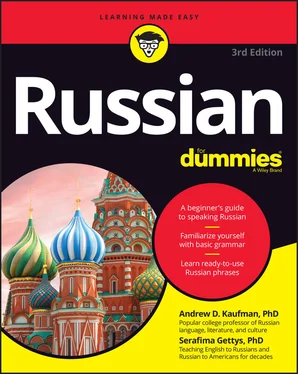Serafima Gettys - Russian For Dummies
Здесь есть возможность читать онлайн «Serafima Gettys - Russian For Dummies» — ознакомительный отрывок электронной книги совершенно бесплатно, а после прочтения отрывка купить полную версию. В некоторых случаях можно слушать аудио, скачать через торрент в формате fb2 и присутствует краткое содержание. Жанр: unrecognised, на английском языке. Описание произведения, (предисловие) а так же отзывы посетителей доступны на портале библиотеки ЛибКат.
- Название:Russian For Dummies
- Автор:
- Жанр:
- Год:неизвестен
- ISBN:нет данных
- Рейтинг книги:4 / 5. Голосов: 1
-
Избранное:Добавить в избранное
- Отзывы:
-
Ваша оценка:
- 80
- 1
- 2
- 3
- 4
- 5
Russian For Dummies: краткое содержание, описание и аннотация
Предлагаем к чтению аннотацию, описание, краткое содержание или предисловие (зависит от того, что написал сам автор книги «Russian For Dummies»). Если вы не нашли необходимую информацию о книге — напишите в комментариях, мы постараемся отыскать её.
Russian For Dummies
Russian For Dummies
Russian For Dummies — читать онлайн ознакомительный отрывок
Ниже представлен текст книги, разбитый по страницам. Система сохранения места последней прочитанной страницы, позволяет с удобством читать онлайн бесплатно книгу «Russian For Dummies», без необходимости каждый раз заново искать на чём Вы остановились. Поставьте закладку, и сможете в любой момент перейти на страницу, на которой закончили чтение.
Интервал:
Закладка:
For your convenience, we marked some information in this book with special icons. Check out this guide to the icons, and the next time you see one of them, you’ll know what to expect!
 From famous Russian writers to a polite way to decline an invitation, this icon marks a wide variety of curious and useful facts about Russian culture.
From famous Russian writers to a polite way to decline an invitation, this icon marks a wide variety of curious and useful facts about Russian culture.
 The website associated with this book gives you the opportunity to hear Russian in action. The site features audio files of native Russian speakers bringing to life some of the dialogues from the pages of this book. Check it out at:
The website associated with this book gives you the opportunity to hear Russian in action. The site features audio files of native Russian speakers bringing to life some of the dialogues from the pages of this book. Check it out at: www.dummies.com/go/russianfd3e .
 This icon points out some important information about Russian that’s worth remembering.
This icon points out some important information about Russian that’s worth remembering.
 This icon signals a useful bit of information that can make life easier for you, whether it’s a handy way to remember a useful word or an insider’s advice on how to better handle a certain situation.
This icon signals a useful bit of information that can make life easier for you, whether it’s a handy way to remember a useful word or an insider’s advice on how to better handle a certain situation.
 This icon attracts your attention to something you need to know to avoid a common mistake.
This icon attracts your attention to something you need to know to avoid a common mistake.
Beyond the Book
In addition to what you’re reading right now, this product also comes with a free access-anywhere Cheat Sheet. To get this Cheat Sheet, simply go to www.dummies.com and type Russian For Dummies Cheat Sheetin the Search box.
Where to Go from Here
Now that you’re familiar with the anatomy of Russian For Dummies, 3rd Edition, you can embark on your journey. You can start anywhere, and you don’t have to go in a specific order. Just choose a topic that seems appealing, find the corresponding chapter in the table of contents, and start speaking Russian!
If you’re at a loss about where to start, please take our advice and begin with Chapter 2: It provides you with a very powerful tool — the ability to read Russian. Chapter 3is a good place to get a grasp on the essentials of Russian grammar. After that, you can go straight to the sections that deal with information you need urgently. Wherever you decide to start, you can find plenty of useful phrases to get you speaking Russian and exploring the benefits that your language skill brings. And now we wish you Cчacтливoгoпути!(sh’ees- lee -vah-vah pooh- tee !) ( Bon voyage! ) .
Part 1
Getting Started
IN THIS PART …
Learn the basics of Russian.
Explore the Russian alphabet.
Understand basic Russian grammar.
Say some simple Russian expressions.
Get your numbers, times, and measurements straight.
Identify items at home using Russian.
Chapter 1
Russian in a Nutshell
IN THIS CHAPTER
 Approaching the Russian alphabet
Approaching the Russian alphabet
 Looking at grammar in a new light
Looking at grammar in a new light
 Getting started with some useful words and expressions
Getting started with some useful words and expressions
 Putting Russian to use in common social situations
Putting Russian to use in common social situations
 Taking Russian on the road
Taking Russian on the road
Russian has a reputation for being a difficult language. Is it? We would say that different is a better word to describe the experience of studying Russian. Russian actually is a distant cousin of English. Both languages belong to a huge Indo-European family of languages — unlike, say, Arabic, Chinese, or Japanese, which belong to completely different language-family clans.
This chapter provides you a taste of Russian. Get ready to study this fascinating language!
Discovering How Easy the Russian Alphabet Really Is
If you were to ask people on the street what they think the most difficult thing about learning Russian is, most of them (slightly taken aback by your question) would likely say, “The alphabet!”
But we’re here to tell you that nothing could be further from the truth: The Russian alphabet is perhaps the easiest part of learning Russian. In fact, you may be surprised to hear that most people are able to start reading Russian in several hours. That’s how easy the Russian alphabet is!
Don’t believe us? Consider this: The Russian alphabet, often called the Cyrillic alphabet, was named after a ninth-century Byzantine monk named Cyril, who developed it with the help of his brother, Methodius. (Please don’t ask us why Methodius’s name wasn’t added to the name of the alphabet. Life isn’t fair.) Cyril and Methodius wanted to translate the Bible into one of the Slavic languages spoken by the Eastern European pagan tribes, because the brothers were planning to convert those tribes to Christianity. These languages had never been written down before. When the brothers were creating their alphabet, they borrowed quite a few letters from the Latin alphabet to indicate the sounds produced by the tribes. Luckily for those tribes (and for anyone studying Russian), a lot of the borrowed letters sound the same in Russian as they do in any Latin-based alphabet (like English).
Are you ready to jump in and start reading Russian? Chapter 2shows you how to sound out the letters of the Russian alphabet.
Tackling Basic Grammar
In addition to the alphabet, grammar is responsible for earning Russian its reputation for being a difficult language. Don’t worry, though! Chapter 3makes your transition from English grammar to Russian grammar as smooth as possible. We give you the scoop on Russian nouns, pronouns, adjectives, verbs, adverbs, and sentence construction.
 One benefit of Russian: Compared with English, which enforces the strictest order of words on its speakers, Russian allows a completely free, almost anarchic order of words. In the sentence “The dog chased the boy,” for example, the Russian words for boy and dog can switch places, but the sentence will still mean “The dog chased the boy.”
One benefit of Russian: Compared with English, which enforces the strictest order of words on its speakers, Russian allows a completely free, almost anarchic order of words. In the sentence “The dog chased the boy,” for example, the Russian words for boy and dog can switch places, but the sentence will still mean “The dog chased the boy.”
But to fully enjoy this freedom of word order, Russians had to pay a dear price in the form of six grammatical cases (nominative, genitive, accusative, dative, instrumental, and prepositional), which anybody who speaks Russian has to juggle constantly to create sentences that make sense. Don’t let this fact intimidate you, however. With the guidelines we provide in Chapter 3, you’ll have a handle on cases in no time.
Читать дальшеИнтервал:
Закладка:
Похожие книги на «Russian For Dummies»
Представляем Вашему вниманию похожие книги на «Russian For Dummies» списком для выбора. Мы отобрали схожую по названию и смыслу литературу в надежде предоставить читателям больше вариантов отыскать новые, интересные, ещё непрочитанные произведения.
Обсуждение, отзывы о книге «Russian For Dummies» и просто собственные мнения читателей. Оставьте ваши комментарии, напишите, что Вы думаете о произведении, его смысле или главных героях. Укажите что конкретно понравилось, а что нет, и почему Вы так считаете.












